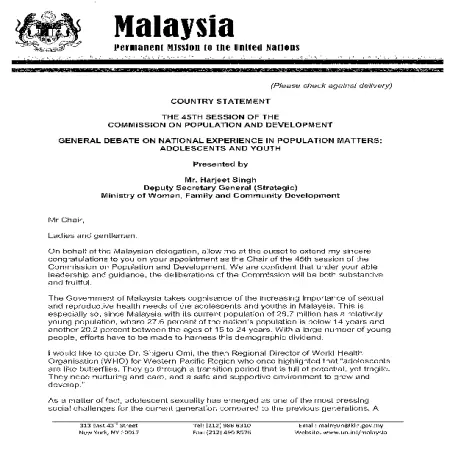TOPICS
|
The 49th session of the Commission on Population and Development on agenda item 4: general debate on national experience in population matters: "strengthening the demographic evidence base for the post - 2015 development agenda", New York
Item Type: Country Statement
Year: 2016
Abstract: The Department of Statistics Malaysia (DOSM) has been responsible for undertaking the Population and Housing Censuses of Malaysia every years since 1970. The Census remains the main source of data collection aimed at providing a comprehensive set of statistical
information about the...[Read More]
|
|
|
|
|
|
Tips beriadah bersama anak kecil
Item Type: Article
Year: 2015
Abstract: Naturally little children have a wide variety. It can even dampen the atmosphere of a planned vacation. Some preparation tips can be practiced by parents before taking the child to go on vacation such as adequate and appropriate clothing, medicines, small bags, important documents,...[Read More]
|
|
|
|
|
|
Toleh kiri dan toleh kanan
Item Type: Article
Year: 2015
Abstract: The aspect of safety in the family needs to be educated and made a daily practice and needs to be educated with patience without despair. There are some simple tips to practice in family safety such as don’t stop praying, keep dangerous and important equipment in a special place, safe...[Read More]
|
|
|
|
|
|
The 47th session of the Commission on Population and Development on agenda item 4: general debate on national experience in population matters: assessment of the status of implementation of the programme of action of the international conference on population and development, New York, 8 April 2014
Item Type: Country Statement
Year: 2014
Abstract: Malaysia shares the view that the current state of the world’s population is one of unprecedented diversity and change, reflected in new patterns of fertility, mortality, migration, urbanisation and ageing. The continuation and consequences of these population trends will present both...[Read More]
|
|
|
|
|
|
The role of human capital in Malaysia's economic development
Item Type: Conference or Workshop Item
Year: 2014
Abstract: This paper examines the impact of human capital on economic development using Malaysia as an example. The evidence shows that Malaysia’s economic growth among the upper middle income countries has been driven considerably by resource exports. The country has not demonstrated strong...[Read More]
|
|
|
|
|
|
The effectiveness of human resource training programme at the National Population and Family Development Board
Item Type: Thesis
Year: 2012
Abstract: Training is a part of human basic needs to achieve perfects or efficiency in doing task. In the public service, training is a must for everyone in order to enhance their skills, knowledge and attitude. This study is to find out the effectiveness of Human Resource Training Policy. The...[Read More]
|
|
|
|
|
|
The impact of Indonesian migrants from the locals' perception: a study in Sabah, Malaysia
Item Type: Scientific Poster
Year: 2012
Abstract: Being a developed country, Malaysia has been receiving a large number of labour migrants from other neighboring countries. Statistics show that the total number of non-Malaysians in 2010 is 2.3 million compared to 1.3 million in the year 2000. It is over 8 percent of the total...[Read More]
|
|
|
|
|
|
The 45th session of the Commission on Population and Development at the general debate on national experience in population matters: adolescents and youth, New York, 24th April, 2012
Item Type: Country Statement
Year: 2012
Abstract: The Government of Malaysia takes cognisance of the increasing importance of sexual and reproductive health needs of the adolescents and youths in Malaysia. Since Malaysia with its current population of 28.7 million has a relatively young population, where 27.6 percent of the nation's...[Read More]
|
|
|
|
|
|
The Philippine pension system: promoting fairness and sustainability
Item Type: Conference or Workshop Item
Year: 2012
Abstract: This paper presentation about sharing knowledge on the retirement system in the Phillippines, currently characterized by a four-pillar structure. The first pillar refers to social assistance programs created to address the needs of the elderly poor. The second pillar covers the...[Read More]
|
|
|
|
|
|
The prevalence of work-family conflict among mothers in Peninsular Malaysia
Item Type: Article
Year: 2011
Abstract: Achieving work-family balance is dependent on managing the conflict between work and family roles. This study focuses on the prevalence of work-family conflict among mothers in Peninsular Malaysia. The objective of this study is to examine the relationship between perceived work-family...[Read More]
|
|
|
|
|














